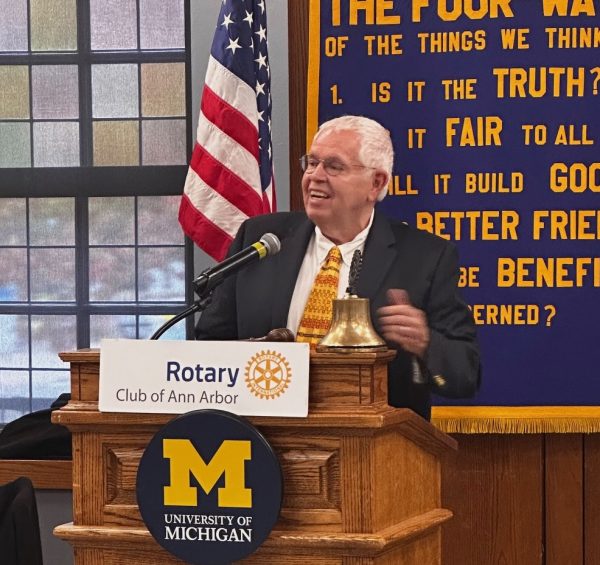President Dawn started the meeting with our patriotic song and the 4-way test.
Today’s inspirational message, provided by Kathy Waugh, started with a quote from Maya Angelou that reminded us of the impact we have on each other, every day. Even when we are faced with negativity and reactivity, when we respond with kindness, people notice.
Shelley MacMillan led us in signing the Hymn of Nations.
Today we acknowledged 5 birthdays in the coming week, and 3 anniversaries of 15 years or more. Guests and visitors included Mike Danielson (Millie Danielson’s son) representing the Rotary Club of Arcadia, a guest who was the recipient of a Rotary scholarship, a visitor who is currently working on her PhD in Mathematics at UM, and two visitors from the Washtenaw County Health Department (former director and the nursing and communications director). Thank you to today’s meeting helpers: Barbara Eichmuller, Mary Sutton, Larry Gray, Carolyn Hiatt, Deb Bolino, Fernando Leon, Jody Tull and Pattie Katcher.
Announcements
A card for the family of Jim Cook, former Club President, is available for your signing. The Send Hunger Packing event is coming up on Nov 8th. The goal is to pack 50,000 meals with 200 volunteers. Now, more than ever, we need to focus on feeding hungry families.
Joanne Pierson gave a wonderful tribute to and remembrance of Agnes Reading, who recently passed away. Agnes was such a loving and giving member who was active in Rotary events until just before her passing. She will be tremendously missed.

President Dawn gave an update of the Strategic Planning for 2025-26. There are six different topics and areas that were discussed: 1) Club Vision Statement, 2) Increase our impact, 3) Expand our reach, 4) Enhance participant engagement, 5) Increase our ability to adapt and 6) Goal monitoring.
Rosemarie Rowney introduced our speaker, Matthew Boulton who is currently serving as the Senior Associate Dean at the School of Public Health. Before his academic career, he was a state epidemiologist, he has authored dozens of articles and is the recipient of of many prestigious awards in the field of public health.
 Dr. Boulton’s presentation was titled Polio: Past, Present & Challenges to Eradication. Dr. Bolton gave us a quick lesson on polio which is caused by an RNA virus that is prone to mutations. There are 3 types of wild-type polio and one must be vaccinated for all three to have protection as it is a highly contagious virus. Polio affects mainly children under the age of 5 and there is no treatment once infected. About 1 in 200 cases result in paralysis, particularly of the legs and 5-10% die due to breathing issues.
Dr. Boulton’s presentation was titled Polio: Past, Present & Challenges to Eradication. Dr. Bolton gave us a quick lesson on polio which is caused by an RNA virus that is prone to mutations. There are 3 types of wild-type polio and one must be vaccinated for all three to have protection as it is a highly contagious virus. Polio affects mainly children under the age of 5 and there is no treatment once infected. About 1 in 200 cases result in paralysis, particularly of the legs and 5-10% die due to breathing issues.
The first known clinical description of polio was in 1789 and in the 19th and 20th centuries there were frequent epidemics of polio. The worst in the US was in 1952: 58,000 cases causing 3,200 deaths and 21,000 left with paralysis. By the mid 20th century, polio either killed or paralyzed more than 500,000 cases worldwide. In 1949 there was a breakthrough in the research and that resulted in winning the Nobel Prize in 1954. Jonas Salk is widely known as a pioneer in the research and development of a vaccine. He was at the UM working on this research in 1942 and then relocated to the University of Pittsburgh to set up a polio research lab. The first vaccination was produced in 1953 with field testing in 1954 where 1.8 million children were enrolled. It was so successful that the trial ended in 1955 because it was determined to be safe and effective and we needed to implement it right away. One of UM’s proudest moments was when Dr. Salk gave a national press conference at Rackham Auditorium in 1955 and he became a national and international hero.
Since that time, polio cases dropped significantly such that by 1960 there were 2,500 cases. This was also the time that a new oral vaccine (aka a ‘live’ vaccine) was developed by Albert Sabin. We then saw a very steep decline – by 1965 there were 64 cases, and the last US case was in 1979. This was the same year that Rotary International embarked on the first polio vaccine efforts in the Philippines. By 1994, the World Health Organization certified that we were polio-free!
However, polio still is found in a few countries, primarily Afghanistan and Pakistan, which continues to experience the wild polio type 1. It’s noteworthy to say that we went from 125 countries to 2! Dr. Boulton ended his talk by discussing more data and the ultimate challenge of achieving polio eradication.








